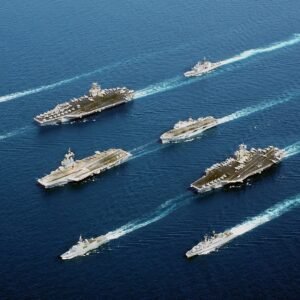I. Introduction
The Admiral Kuznetsov aircraft carrier is a formidable naval vessel that has played a significant role in projecting Russian military power on the global stage. Built by the Soviet Union and commissioned in 1990, this aircraft carrier has become an integral part of the Russian Navy’s fleet.
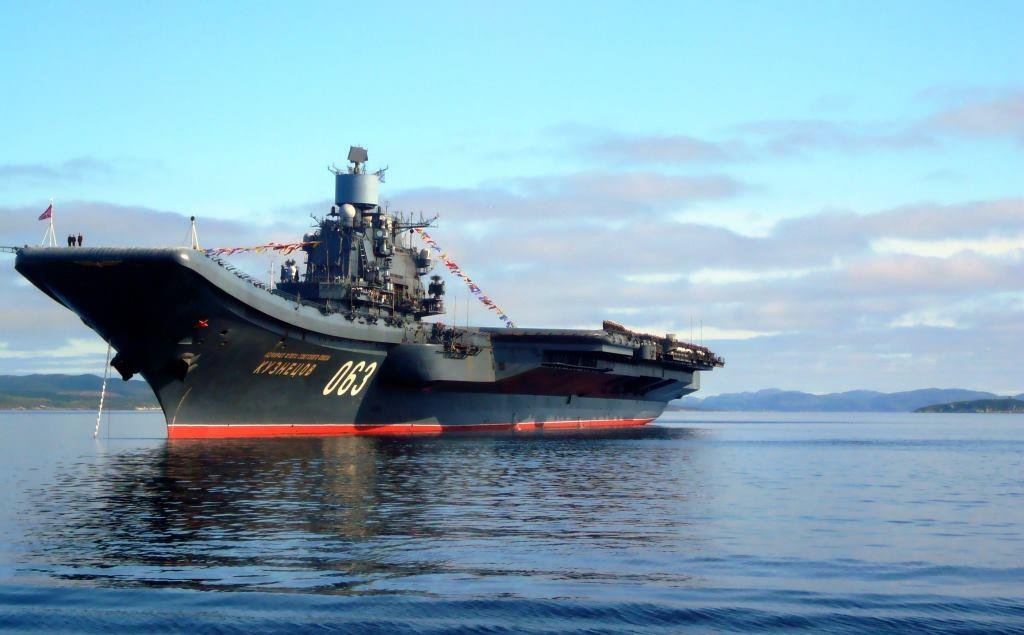
II. Design:
The design of the Admiral Kuznetsov aircraft carrier began in the 1970s and it was intended to be a versatile platform capable of performing multiple roles, including air defense, anti-submarine warfare, and strike missions. The carrier features a ski-jump ramp at the bow, which allows for the launch of fixed-wing aircraft using a Short Take-Off But Arrested Recovery (STOBAR) system.
The carrier has a displacement of around 58,500 tons and a length of about 305 meters (1,001 feet). It is powered by a conventional steam propulsion system, with eight boilers providing steam to four steam turbines that drive four shafts, giving the carrier a top speed of around 29 knots.
The flight deck of Admiral Kuznetsov can accommodate around 40 fixed-wing aircraft, including a mix of fighters, strike aircraft, and helicopters. It has a hangar deck below the flight deck for aircraft storage and maintenance. The carrier is also equipped with defensive weapons, such as surface-to-air missile systems and anti-submarine warfare capabilities.
III. Development:
The construction of Admiral Kuznetsov began in 1982 at the Black Sea Shipyard in Ukraine. It was launched in 1985 and commissioned into the Soviet Navy in 1991, shortly before the dissolution of the Soviet Union. The ship was named after Nikolay G. Kuznetsov, a prominent Soviet admiral.
The development and construction of Admiral Kuznetsov faced several challenges, including delays and budget constraints. The collapse of the Soviet Union further complicated the project, as it disrupted supply chains and led to the division of the Soviet Navy’s assets among the newly independent states.
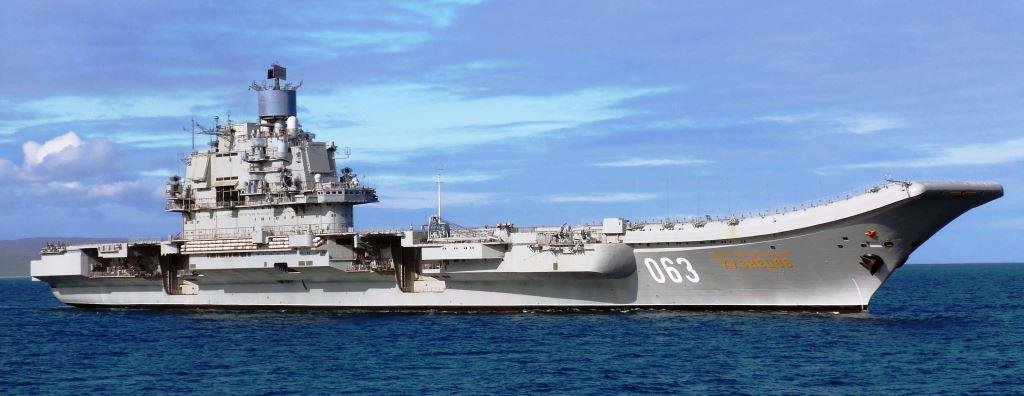
A. Key Specifications:
| Specification | Details |
| Displacement | Approximately 58,500 tons |
| Length overall | 306 meters (1,004 feet) |
| Beam (Width) | 72 meters (236 feet) |
| Draft | 10.2 meters (33.5 feet) |
| Propulsion | Steam turbines, 8 boilers, 4 shafts |
| Speed | 29 knots (54 km/h; 33.5 mph) |
| Range | 8,500 nautical miles (15,700 km; 9,800 mi) |
| Crew | Approximately 1,960 personnel |
| Air Wing Capacity | Around 40 fixed-wing aircraft and helicopters |
| Aircraft Launch System | Ski-jump ramp |
| Arresting Gear | 3 arrester wires |
| Armament | – Anti-ship missiles (P-700 Granit) |
| – Surface-to-air missiles (S-300F/Kortik) | |
| – Close-in weapon systems | |
| – Anti-submarine warfare (ASW) helicopters | |
| – Artillery guns | |
| Complement of Aircraft | – Sukhoi Su-33 |
| – Mikoyan MiG-29K/KUB | |
| – Sukhoi Su-25UTG/UBP | |
| – Kamov Ka-27/28/29/31 | |
| – Kamov Ka-52K | |
| – Mil Mi-8/Mi-17 |
B. Admiral Kuznetsov’s Aircraft Carrier is Equipped with Various Armaments
- Aircraft: The primary offensive armament of Admiral Kuznetsov is its complement of fixed-wing aircraft and helicopters. The carrier can carry a mix of aircraft, including fighter jets, attack aircraft, and reconnaissance planes. The exact composition of the air wing may vary depending on the mission requirements.
- Anti-ship Missiles: The carrier is armed with P-700 Granit (NATO reporting name: SS-N-19 Shipwreck) anti-ship missiles. These long-range supersonic missiles are designed to engage surface targets, including enemy ships. The P-700 Granit missiles have a range of around 400 kilometers (250 miles) and carry a large warhead.
- Surface-to-Air Missiles: To provide air defense capabilities, Admiral Kuznetsov is equipped with a combination of surface-to-air missile systems. The carrier typically carries S-300F (SA-N-6 Grumble) and/or Kortik (CADS-N-1) missile systems for protection against airborne threats, such as enemy aircraft and incoming missiles.
- Close-in Weapon Systems: Close-in defense against anti-ship missiles, aircraft, and small boats is provided by close-in weapon systems (CIWS). The Admiral Kuznetsov is equipped with CIWS, such as the Kashtan (CADS-N-1) system or its upgraded variant, Kashtan-M. These systems employ both guns and short-range missiles for close-range defense.
- Anti-Submarine Warfare (ASW) Weapons: The carrier carries anti-submarine warfare helicopters, such as the Kamov Ka-27 or Ka-27S, which are equipped with torpedoes, depth charges, and sonobuoys. These helicopters provide ASW capabilities to detect, track, and engage enemy submarines.
- Guns: Admiral Kuznetsov features a range of guns for self-defense and support roles. These include various caliber artillery guns, such as 130mm and 30mm guns, for engaging surface and air targets at shorter ranges.
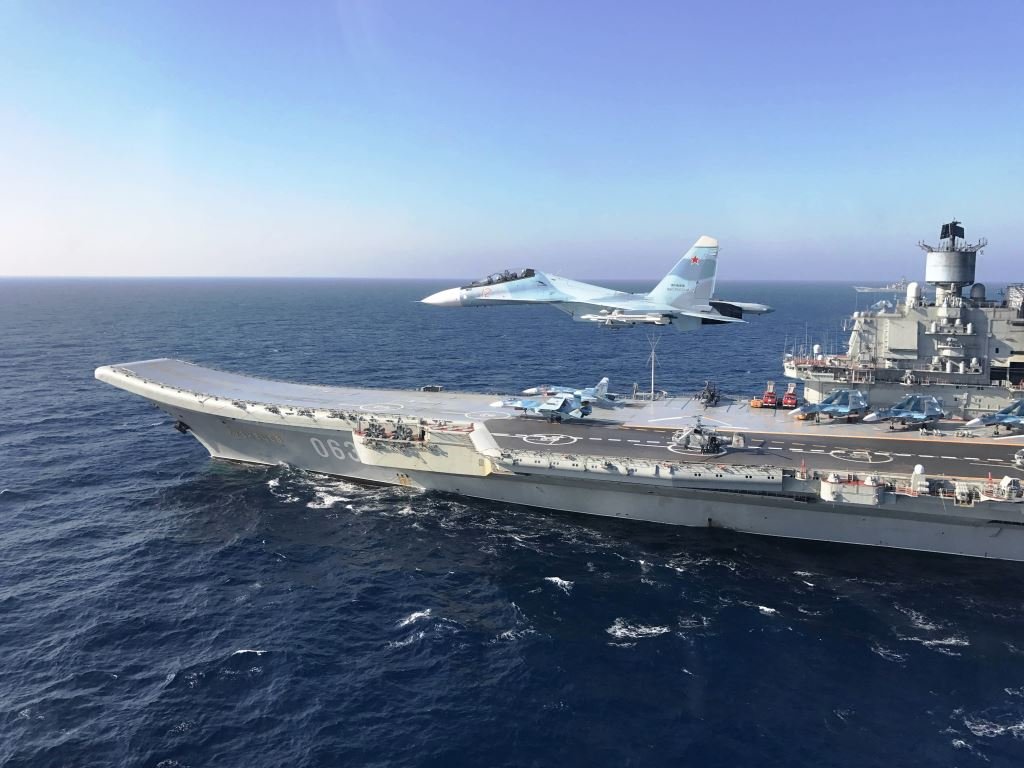
C. Admiral Kuznetsov’s Aircraft Carrier is Loaded with Many Types of Avionics
- Aircraft Landing Systems: The carrier employs various systems to assist with aircraft takeoff and landing operations. These include an optical landing system, such as the Fresnel lens-based “meatball” system, which helps pilots align and land their aircraft on the carrier deck safely. The carrier may also feature a Precision Approach Radar (PAR) to assist with aircraft approach and landing.
- Air Traffic Control: To manage the movement of aircraft on and around the carrier, the ship’s air traffic control (ATC) system plays a vital role. The ATC system allows controllers to monitor and coordinate aircraft operations, ensuring safe and efficient takeoffs, landings, and in-flight operations.
- Navigation Systems: The carrier relies on advanced navigation systems to accurately determine its position at sea. This may include an integrated navigation system that combines inputs from various sensors such as GPS, inertial navigation systems (INS), and radar navigation.
- Communication Systems: Effective communication is crucial for carrier operations. The carrier will have sophisticated communication systems that enable seamless communication between the carrier’s command center, aircraft, and other naval units. These systems may include secure voice and data communication capabilities, encrypted communication channels, and radio systems.
- Radar and Sensor Systems: The carrier is likely equipped with radar systems to provide situational awareness and detect potential threats, such as enemy aircraft or missiles. These radar systems help track and identify targets, support air traffic control operations, and contribute to the carrier’s overall air defense capabilities.
- Electronic Warfare Systems: Modern carriers incorporate electronic warfare systems to detect and counter electronic threats. These systems may include radar warning receivers (RWRs) to detect and identify radar emissions, electronic countermeasures (ECM) to disrupt enemy radar and missile guidance systems, and other defensive measures to protect the carrier and its aircraft from electronic threats.
IV. The Admiral Kuznetsov Aircraft Carrier Has Faced Challenges
- Reliability and Maintenance: The carrier has experienced multiple breakdowns and mechanical failures, particularly with its propulsion system. These issues have resulted in extended periods of inoperability and limited the carrier’s availability for active service.
- Age and Obsolescence: Admiral Kuznetsov was commissioned into the Russian Navy in 1991, making it a relatively old vessel. The carrier’s design and technology have become outdated compared to more modern aircraft carriers of other nations. Its aging systems and equipment pose challenges in terms of efficiency, effectiveness, and compatibility with newer technologies.
- Combat Capabilities: While Admiral Kuznetsov possesses various armaments, its combat capabilities have been a subject of scrutiny. The carrier’s air defense systems and overall offensive capabilities have been questioned, particularly in comparison to modern carrier designs employed by other countries. Upgrading and modernizing the carrier’s armament systems and combat capabilities have become essential to overcome these challenges.
- Modernization and Funding: The modernization of Admiral Kuznetsov has faced challenges due to funding constraints and logistical difficulties. The carrier requires significant investments to address its operational deficiencies and upgrade its systems. However, funding limitations and competing priorities within the Russian Navy have slowed down the modernization process.
- Accidents and Incidents: Admiral Kuznetsov has experienced notable accidents and incidents that have further hampered its operational readiness. In 2018, during a floating dry dock accident, the carrier sustained significant damage, including a large gash in its hull. This accident further delayed the carrier’s operational availability and highlighted the need for extensive repairs.
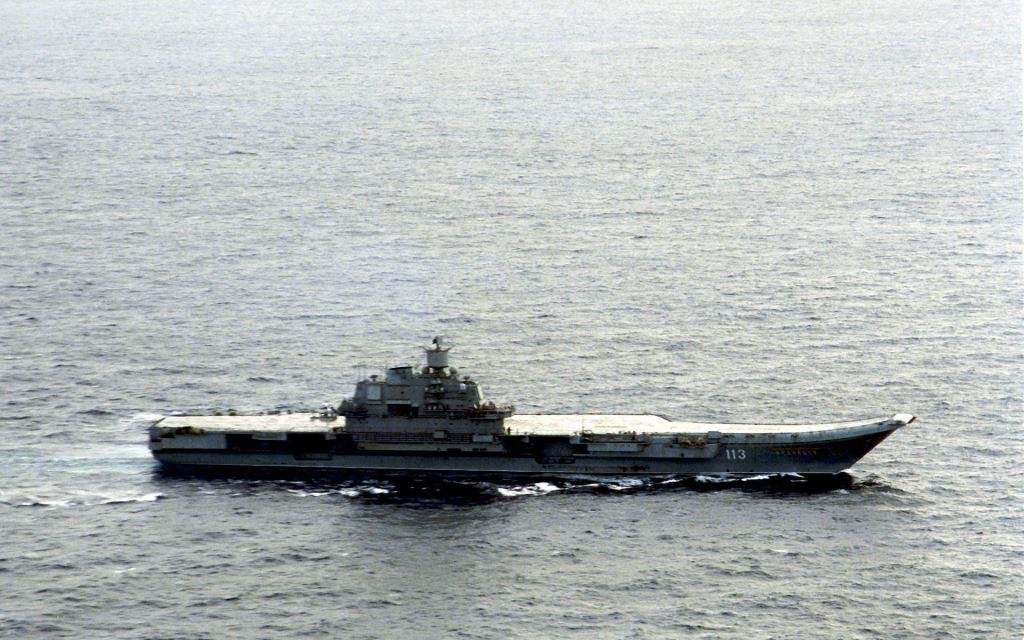
V. The Admiral Kuznetsov Aircraft Carrier Deployment History
Admiral Kuznetsov’s Aircraft Carrier has been deployed on various missions and exercises throughout its service.
- Syrian Civil War (2016-2017): One of the most significant deployments of Admiral Kuznetsov was their participation in the Syrian Civil War. In October 2016, the carrier, accompanied by a naval task force, sailed to the Mediterranean Sea to support Russian military operations in Syria. During this deployment, the carrier conducted airstrikes against targets in Syria using its embarked aircraft.
- Mediterranean and Atlantic Deployments: Admiral Kuznetsov has conducted multiple deployments to the Mediterranean Sea, primarily as part of routine naval exercises and demonstrations of Russian naval presence. It has also ventured into the Atlantic Ocean during some of these deployments. These operations aim to showcase Russia’s maritime capabilities and project power in strategic regions.
- Joint Exercises: The carrier has participated in joint naval exercises with other nations, including exercises with the Chinese Navy. These exercises serve to enhance interoperability, promote military cooperation, and provide training opportunities for the participating navies.
- Northern Fleet Operations: As the flagship of the Russian Navy, Admiral Kuznetsov has also been involved in various operational activities conducted by the Northern Fleet. These activities include training exercises, patrols, and readiness operations in the Arctic and North Atlantic regions.
VI. The Admiral Kuznetsov Carrier Carry Many Aircraft
The Admiral Kuznetsov aircraft carrier is designed to carry a mix of fixed-wing aircraft and helicopters. The specific aircraft complement can vary depending on the mission requirements and operational needs.
A. Fixed-Wing Aircraft:
- Sukhoi Su-33: The Su-33 is a carrier-based multirole fighter aircraft. It is the primary fixed-wing aircraft operated from Admiral Kuznetsov and is capable of air superiority, air defense, and ground attack missions.
- Mikoyan MiG-29K/KUB: The MiG-29K/KUB is a naval variant of the MiG-29 fighter aircraft. It is designed for carrier-based operations and can perform air-to-air and air-to-ground missions.
- Sukhoi Su-25UTG/UBP: The Su-25UTG/UBP is a two-seat trainer and combat aircraft. It is used for training purposes and can also be configured for ground attack missions.
B. Helicopters:
- Kamov Ka-27/28/29/31: The Ka-27 series helicopters are used for various roles, including anti-submarine warfare (ASW), search and rescue, and transport operations. They are equipped with radar systems, sonobuoys, torpedoes, and other ASW equipment.
- Kamov Ka-52K: The Ka-52K is a naval variant of the Ka-52 Alligator attack helicopter. It is designed for anti-ship and ground attack missions and carries a wide range of weapons, including anti-ship missiles, rockets, and guided bombs.
- Mil Mi-8/Mi-17: The Mi-8/Mi-17 helicopters serve in multiple roles, including transport, search and rescue, and anti-submarine warfare. They can carry troops, equipment, and supplies, and are equipped with various sensors and weapons for their respective missions.

VII. The Admiral Kuznetsov Strike Group
The Admiral Kuznetsov aircraft carrier, when deployed, is often accompanied by a naval task force or strike group that provides support and protection. The composition of the strike group can vary depending on the specific mission and operational requirements.
Surface Combatants: The strike group typically includes surface combatants, such as guided-missile cruisers or destroyers. These ships provide air defense capabilities, and anti-submarine warfare capabilities, and contribute to the overall defense of the strike group. They may also be equipped with land-attack capabilities to support the carrier’s mission.
Submarines: Submarines may be part of the strike group to provide additional anti-submarine warfare capabilities and enhance the group’s overall defensive capabilities. Submarines can detect and track enemy submarines, contribute to intelligence gathering, and potentially engage enemy surface ships if necessary.
Support Ships: Various support ships, such as supply vessels and replenishment ships, may accompany the strike group to provide logistical support. These ships carry fuel, ammunition, food, and other supplies necessary to sustain the carrier and its accompanying vessels during extended deployments.
Auxiliary Ships: Depending on the mission requirements, auxiliary ships like tugs, salvage vessels, and research ships may be included in the strike group. These ships provide specialized support and capabilities as needed.
Read More:- Italian Aircraft Carrier Cavour: A Powerful Force.
Latest Blog:- The USS Dwight D Eisenhower Aircraft Carrier







